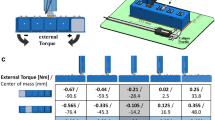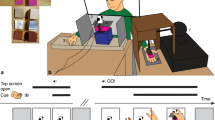Abstract
Using a precision grip-lifting task, we examined how sensorimotor memory for weight asymmetry transfers across changes in hand and object configuration. We measured object tilt when participants lifted a visually symmetric box with an offset centre of mass. Transfer was assessed after participants lifted the box 10 times, during which the large tilt observed in the first lift was reduced. Consistent with previous work of Salimi et al. (J Neurophysiol 84:2390–2397, 2000), we found that when the object was rotated 180°, participants failed to update their sensorimotor memory appropriately. Instead, participants acted as if the object did not rotate and negative transfer was observed. However, when the hand was rotated 180° around the object, participants were able to correctly update sensorimotor memory and positive transfer was observed. This finding argues against the hypothesis that sensorimotor memory is digit-specific because the rotation of the hand (like rotation of the object) changes the forces that each digit must generate to prevent tilt. Positive transfer was also observed when both the hand and object were rotated. This suggests that the rotation of the hand may facilitate rotation of an internal representation of the object. Finally, we found positive transfer of weight asymmetry across the two hands but only when the second hand was rotated such that homologous digits of each hand gripped the same contact surfaces. We suggest that good transfer is observed under these conditions because, when we pass objects from hand to hand, we typically place homologous digits of the two hands in similar locations on the object.


Similar content being viewed by others
References
Davidson PR, Wolpert DM (2004) Internal models underlying grasp can be additively combined. Exp Brain Res 155:334–340
Edin BB, Westling G, Johansson RS (1992) Independent control of human finger-tip forces at individual digits during precision lifting. J Physiol 450:547–564
Ellis RR, Flanagan JR, Lederman SJ (1999) The influence of visual illusions on grasp position. Exp Brain Res 125:109–114
Flanagan JR, Beltzner MA (2000) Independence of perceptual and sensorimotor predictions in the size-weight illusion. Nat Neurosci 3:737–741
Flanagan JR, King S, Wolpert DM, Johansson RS (2001) Sensorimotor prediction and memory in object manipulation. Can J Exp Psychol 55:87–95
Flanagan JR, Bowman MC, Johansson RS (2006) Control strategies in object manipulation tasks. Curr Opin Neurobiol 16:650–659
Goodwin AW, Jenmalm P, Johansson RS (1998) Control of grip force when tilting objects: effect of curvature of grasped surfaces and applied tangential torque. J Neurosci 18:10724–10734
Gordon AM, Forssberg H, Johansson RS, Westling G (1991a) Integration of sensory information during the programming of precision grip: comments on the contributions of size cues. Exp Brain Res 85:226–229
Gordon AM, Forssberg H, Johansson RS, Westling G (1991b) The integration of haptically acquired size information in the programming of precision grip. Exp Brain Res 83:483–488
Gordon AM, Forssberg H, Johansson RS, Westling G (1991c) Visual size cues in the programming of manipulative forces during precision grip. Exp Brain Res 83:477–482
Gordon AM, Westling G, Cole KJ, Johansson RS (1993) Memory representations underlying motor commands used during manipulation of common and novel objects. J Neurophysiol 69:1789–1796
Gordon AM, Forssberg H, Iwasaki N (1994) Formation and lateralization of internal representations underlying motor commands during precision grip. Neuropsychologia 32:555–568
Grandy MS, Westwood DA (2006) Opposite perceptual and sensorimotor responses to a size-weight illusion. J Neurophysiol 95:3887–3892
Jenmalm P, Johansson RS (1997) Visual and somatosensory information about object shape control manipulative fingertip forces. J Neurosci 17:4486–4499
Jenmalm P, Goodwin AW, Johansson RS (1998) Control of grasp stability when humans lift objects with different surface curvatures. J Neurophysiol 79:1643–1652
Johansson RS, Westling G (1984) Roles of glabrous skin receptors and sensorimotor memory in automatic control of precision grip when lifting rougher or more slippery objects. Exp Brain Res 56:550–564
Johansson RS, Westling G (1988) Coordinated isometric muscle commands adequately and erroneously programmed for the weight during lifting task with precision grip. Exp Brain Res 71:59–71
Johansson RS, Backlin JL, Burstedt MK (1999) Control of grasp stability during pronation and supination movements. Exp Brain Res 128:20–30
Kosslyn SM (1980) Image and mind. Harvard University Press, Cambridge, p 520
Lukos L, Ansuini C, Santello M (2007) Choice of contact points during multidigit grasping: Effect of predictability of object center of mass location. J Neurosci 27:3894–3903
Quaney BM, Cole KJ (2004) Distributing vertical forces between the digits during gripping and lifting: the effects of rotating the hand versus rotating the object. Exp Brain Res 155:145–155
Salimi I, Frazier W, Reilmann R, Gordon AM (2003) Selective use of visual information signaling objects’ center of mass for anticipatory control of manipulative fingertip forces. Exp Brain Res 150:9–18
Salimi I, Hollender I, Frazier W, Gordon AM (2000) Specificity of internal representations underlying grasping. J Neurophysiol 84:2390–2397
Shepard RN, Cooper LA (1982) Mental images and their transformations. MIT Press/Bradford Books, Cambridge, p 364
Wexler M, Kosslyn SM, Berthoz A (1998) Motor processes in mental rotation. Cognition 68:77–94
Wing AM, Lederman SJ (1998) Anticipating load torques produced by voluntary movements. J Exp Psychol Hum Percept Perform 24:1571–1581
Author information
Authors and Affiliations
Corresponding author
Rights and permissions
About this article
Cite this article
Bursztyn, L.L.C.D., Flanagan, J.R. Sensorimotor memory of weight asymmetry in object manipulation. Exp Brain Res 184, 127–133 (2008). https://doi.org/10.1007/s00221-007-1173-z
Received:
Accepted:
Published:
Issue Date:
DOI: https://doi.org/10.1007/s00221-007-1173-z




